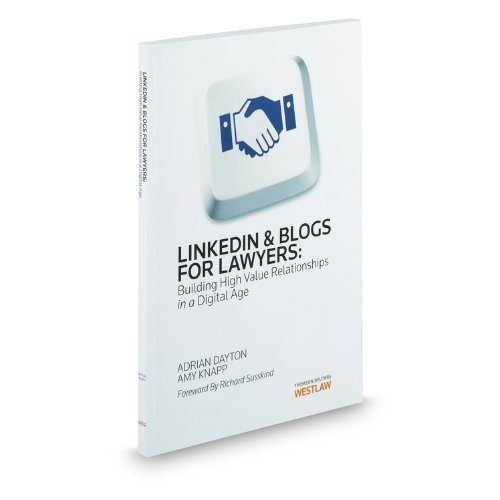Lest there be any doubt about how tardy I am in reviewing these two books, let me point out that, in the time it has taken me to get around to this, the authors of one of the books have already written and published a second book. But my delay in reviewing these is no reason for you to delay in purchasing them. If you are still somewhat of a greenhorn when it comes to the professional networking site LinkedIn, consider consulting one of these useful guides.
 The two books are LinkedIn & Blogs for Lawyers: Building High Value Relationships in a Digital Age, written by Amy Knapp and Adrian Dayton and published by West last January, and LinkedIn in One Hour for Lawyers, written by Dennis Kennedy and Allison C. Shields and published by the American Bar Association’s Law Practice Management Section last March. The Knapp/Dayton book sells for $69, while the Kennedy/Shields book is $34.95 (or $19.95 for LPM Section members).
The two books are LinkedIn & Blogs for Lawyers: Building High Value Relationships in a Digital Age, written by Amy Knapp and Adrian Dayton and published by West last January, and LinkedIn in One Hour for Lawyers, written by Dennis Kennedy and Allison C. Shields and published by the American Bar Association’s Law Practice Management Section last March. The Knapp/Dayton book sells for $69, while the Kennedy/Shields book is $34.95 (or $19.95 for LPM Section members).
In the interest of full disclosure, let me say at the outset that all of these authors are acquaintances of mine and that Amy Knapp and I have worked together as colleagues on several legal-marketing projects over the years. Before the Knapp/Dayton book came out, I had an opportunity to review and comment on an advance copy.
But it was not until the dog days of August that I finally took the time to go through each book in depth. When I finally did, what most surprised me is how different the two are. I started into them asking myself, “Why would the legal profession possibly need two books about LinkedIn?” I ended them concluding that many lawyers would benefit from reading both of these books.
 If I had to sum up the difference between the two books concisely, I would describe it as “strategy” versus “mechanics.” The Knapp/Dayton book focuses more on “why” while the Kennedy/Shields book focuses more on “how.”
If I had to sum up the difference between the two books concisely, I would describe it as “strategy” versus “mechanics.” The Knapp/Dayton book focuses more on “why” while the Kennedy/Shields book focuses more on “how.”
In the Knapp/Dayton book, the LinkedIn chapters were written primarily by Knapp, with input from Dayton. (The book also has chapters on blogging, written by Dayton with input from Knapp.) Knapp is a veteran business development and marketing consultant and she comes at the topic from that perspective. The book starts with a first chapter that asks, “Why LinkedIn for Lawyers?” After endeavoring to answer that question, Knapp follows with a second chapter, “Business Development Case Studies,” that illustrates actual examples of lawyers successfully using LinkedIn to build their practices.
Then she gets to what I consider the most important chapter of the entire book — and it is only three pages long. In Chapter 3, Knapp encourages lawyers, before ever setting foot in LinkedIn, to think through what they want to achieve there in terms of marketing and business development. “If you don’t know where you’re going,” she quotes Yogi Berra, “you will wind up somewhere else.” To help you map out where you are going, Knapp provides a “LinkedIn strategy worksheet.” The answers to that worksheet become the blueprint for creating a LinkedIn profile and for charting other LinkedIn networking.
A Practical Approach
By contrast, Kennedy and Shields dive right into the mechanics. They address the “why” of LinkedIn summarily in a brief introduction — essentially taking it as a given that lawyers should be on LinkedIn. They take your hand and walk you through the steps you need to follow to get “quickly up to speed” on LinkedIn.
Their book is organized as a series of practical lessons. The first starts with the very basic aspects of setting up a LinkedIn account and choosing between the free or paid versions. (The free account is all most lawyers need, they advise.) The second lesson walks the reader through the creation of a basic LinkedIn profile.
An illustration of the different approaches between the two books is in how they cover the “Summary” section of a profile. Knapp/Dayton focus on the content of it, on how to make it compelling, providing guidelines and examples. (I have to confess here, they cite and quote my LinkedIn summary as an example of a good summary.) Kennedy/Shields focus on the how-to of it, describing what it consists of and how many characters can be used to write it. They mention only briefly that this is an important section. “Do not overlook it,” they say. “Describe what you do. Make it interesting.”
Both books go on to describe more advanced aspects of using LinkedIn, from uploading contacts to making connections to participating in groups. Here again, you see the differences in approaches of the books, with the Knapp/Dayton book often focusing on strategic aspects of LinkedIn’s advanced features and the Kennedy/Shields book walking the reader through the steps required to use these advanced features.
The Kennedy/Shields book gets into several advanced topics that the Knapp/Dayton book does not cover. They have two entire chapters on using LinkedIn’s search and advanced search features, which are critical tools for LinkedIn power users. The Knapp/Dayton book has nothing on this. Kennedy/Shields also have chapters on the ethical considerations of using LinkedIn, on using LinkedIn in the hiring process, and on creating LinkedIn company pages. The Knapp/Dayton book covers none of these topics.
The Bottom Line
Before reading these two books, I expected them to be highly redundant. After all, how much different is there to say about LinkedIn? Boy was I wrong. Although they both tackle the same topic, they do so in very different ways. While the Knapp/Dayton book focuses more on strategic marketing and business development, the Kennedy/Shields book is more like an instruction manual for the novice or intermediate user.
Surprisingly, both books offer distinct lessons, tips and insights. You can read both and learn something valuable from each. As a matter of fact, if you are completely new to LinkedIn and intent on becoming an advanced user, you should consider buying both books.
 Robert Ambrogi Blog
Robert Ambrogi Blog